Sri Lanka’s ‘new Dubai’: will Chinese-built city suck the life out of Colombo?
Posted on August 2nd, 2018
Courtesy The Guardian
Iron cannons installed by the Dutch to ward off colonial rivals still line Galle Face Green, a grassy, mile-long promenade along the Colombo seafront. Further out to sea, within range of the guns, a new world power is leaving its mark on Sri Lanka’s capital.
Currently, Port City is just a flat expanse of blank land jutting out into the ocean, growing a fraction larger each day, as dredging ships pour what will eventually amount to 65 million cubic metres of sand.
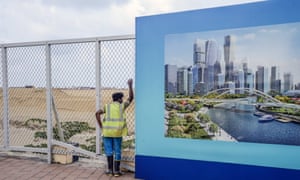
Within a few years, however, Port City will be the site of glass skyscrapers, a busy financial district, hospitals, hotels and even a theme park. Across the world, Chinese companies are developing President Xi Jinping’s Belt and Road Initiative by building new roads, ports and bridges – but in Sri Lanka they are building a whole new metropolis.
Q&A
Cities of the New Silk Road: what is China’s Belt and Road project?
It is a completely new city that will nearly double the size of Colombo right now,” says Janaka Wijesundara, a former director at Sri Lanka’s Urban Development Authority. It is going to drastically change the entire landmass.”
Built on 665 acres (2.6 sq km) of land being reclaimed from the Indian Ocean, the city is designed to be a smaller Singapore, with its own business-friendly tax regime and regulations – and possibly a different legal system to the rest of Sri Lanka.
About 80,000 people are expected to live in the city, with another quarter of a million commuting in every day.
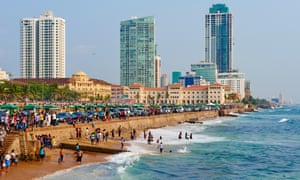
It is the largest single foreign direct investment in Sri Lankan history – a $1.4bn (£1.1bn) project by the state-owned Chinese engineering firm China Communications Construction Company (CCCC).
Artistic impressions of the future Port City show a brightly lit cityscape comparable to Dubai or London’s Canary Wharf. Developers say 1.5 million sq metres of office space will be available and private investment could reach $13bn. Dense high-rises give way to lower-slung residential areas, crisscrossed by parks and canals. A marina and beach line the city’s edges.
It is a world away from the fading bungalows, modest temples and low-slung towers of present-day Colombo. But designers say they have striven to have the new city reflect its roots, according to Daniel Ringelstein, a director at Skidmore, Owings and Merrill (SOM), the firm that created the masterplan for the city’s central business district.
We took inspiration from the colonial era,” he says, highlighting Colombo’s whitewashed colours, elegant arcades and individually expressed, vertically proportioned buildings” as key influences.
The mega-blocks initially favoured by the developers were subdivided by the firm, he says, to create more walkable public space, mimicking the vivid street life of Sri Lankan cities and including an emphasis on natural shade.
The idea to expand Colombo’s business district outward on to land reclaimed from the sea was first proposed in 2004. The city, located along key shipping routes across the Indian Ocean, had been a hub for trade for more than 2,000 years.
But a bloody, 25-year civil war was killing thousands of people each year. Around the time authorities were mulling an early version of Port City, Colombo was struck by its first suicide bombing since 2001. The plans were shelved for five years.
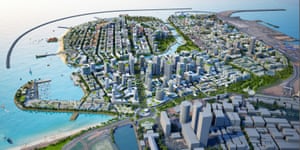
By 2009, the war had been brought to a close, thanks to ruthless offensives by the Sri Lankan army. Then-president Mahinda Rajapaksa declared Sri Lanka open for business – but the spectre of what the UN calls horrific” human rights abuses committed by both the army and the Tamil Tigers continued to ward off most investors.
One major country, however, was happy to fund Sri Lanka’s reconstruction. China offered political cover for Sri Lanka towards the end of the war and had already started to play more of a prominent role on the economic front,” says Dushni Weerakoon, the executive director at the Institute of Policy Studies in Colombo. After the war ended, it all just accelerated.”
In total, Rajapaksa borrowed about $8bn from China, much of which was spent on big-ticket infrastructure in his ancestral home district of Hambantota – which has since become a byword for the risks associated with Chinese loans. A major new airport in Hambantota receives just one flight each day. A new hospital serves as accommodation for Chinese guest workers. Attracting most scrutiny is a port that was upgraded using money borrowed from China. Earlier this year, unable to afford the repayments, Sri Lanka handed control of the port to a subsidiary of CCCC for at least 99 years.
The loans are part of a wave of Chinese investment in south Asia that has been described as the biggest game changer in 100 years”, posing a serious challenge to India, the traditional power in the region.
In 2014, concerns over Chinese loans and corruption played a key part in Rajapaksa’s shock election defeat. The new government promised to rebalance Sri Lanka’s relationship with India, Japan and the west. Though Port City was being funded by foreign investment, rather than a loan, it became a victim of the backlash: the new prime minister, Ranil Wickramasinghe, shelved the project, claiming the dredging would destroy Colombo’s coast.
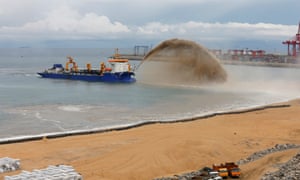
It was a win for environmentalists such as Hemantha Withanage, who heads the Colombo-based Centre for Environmental Justice (CJE). The project is totally harmful to tourism and totally harmful to fishermen,” he says.
W Jude Namal Fernando, a fisherman and trade unionist in Negombo, north of Colombo, says the excavation of sand along the coast is destroying aquatic life and affecting the livelihoods of approximately 8,000 people who make a living from fishing. The habitat belonging to various species has been demolished,” he says. Corals have been removed, disturbing the ecological balance. And the fisheries industry consists of many others apart from fishermen – the livelihood of those who are on the shore and those who transport the catch to the market are also affected.”
The CJE argues that building the new city will require more natural resources than Sri Lanka can sustainably provide. The necessary sand alone would quickly exceed 100 million cubic metres, it says, threatening a fragile marine habitat and the livelihoods of 15,000 fishermen who work in the mining area. The CJE prices the value of the sand at $3.2bn, which it says outweighs the $1.4bn invested by CCCC subsidiary China Harbour in building the city.
The environmental group also warns commutes into the new financial district will add 300,000 daily car journeys, increasing airborne pollution in a city already exceeding World Health Organisation guidelines.
Yet about a year after suspending Port City, in March 2016 the new government announced work would soon resume. CCCC had been claiming to be losing $380,000 each day the project was on hold, and was threatening to sue for compensation. The government says its amended contract with the Chinese firm includes new environmental protections. In an attempt to ease Indian concerns, 20 hectares of Port City originally slated to be given to CCCC in perpetuity was instead granted on a freehold basis. The trucks and dredgers returned. Within two years, Port City was back on schedule, with land reclamation expected to finish by the end of 2018 and the first buildings expected to appear within four years.
As the project takes shape, key questions about how Port City will operate remain unanswered. The new contract has not been released to the public. Sri Lanka has promised its Chinese investors favourable tax rates and business-friendly regulations, but it may be limited in what it can provide, thanks to an IMF loan the country took in 2016 to help pay its debts. Sri Lankan ministers have also said Port City will operate under a separate British-style” legal system – but what that will entail is unclear. Several requests were made to the government to clarify, with no response.
Sri Lankan activists have also raised questions about the power China Harbour will wield in the territory it leases in Port City, where it will effectively act as the landlord – a majority state-owned Chinese corporation deciding who can populate parts of a Sri Lankan city, and under what circumstances.
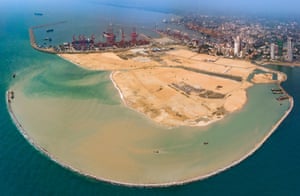
Urban planners say another issue is unresolved: how the burgeoning city will affect the rest of Colombo. That was the missing piece to the brief,” says Ringelstein. How is this city connected to the historic city centre back to the east?”
SOM’s masterplan tried to resolve the problem by creating patches of green space in Port City that will provide views of Colombo. They also encouraged the government to regenerate the western edge of the old city, creating a frontage that looks out on the new one.
The idea is to use green space as a way to mediate between the old and the new,” Ringelstein says. You would hate for this new project to suck the life out of the existing city today.”
Wijesundara, the former Urban Development Authority director, says developers may not even want to establish links between the old and new cities. I will say that Port City will be a separate entity where only a certain class of people will live,” he says. Services may be provided by the local people, but the money coming to them is questionable.”
Additional reporting by Arthur Wamanan.